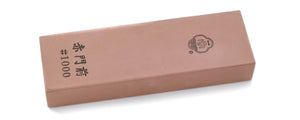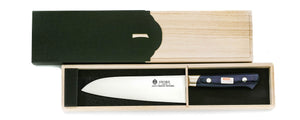The Basic Differences of Single-Edged and Double-Edged Knives
Japanese kitchen knives can generally be divided into two main categories, based on the style of the blade's edge: single-edged knives (also known as single-bevel knives) and double-edged knives (also known as double-bevel knives).
Single-edged knives are typically found in traditional Japanese styles such as yanagiba (for sashimi), deba (for fish filleting), and usuba (for vegetables) knives.
In contrast, double-edged knives are more common in Western-style Japanese knives, such as popular options like gyuto, petty, santoku, nakiri, and sujihiki knives. These designs are known for being more versatile and easy to use, turning them into a popular choice for everyday home cooking, or even in Western cuisine restaurants.
Both single-edged and double-edged knives have their own unique characteristics and advantages. While it is hard to say which is better in general, this blog will help you learn which Japanese knife type is best for you by exploring the features of each type, and their differences.
What is a Single-Edged Knife?
Let's clarify what a single-edged knife is.
A single-edged knife is as simple as it sounds; a knife with a cutting edge sharpened on only one side.
See one of our single-edged santoku knives below, and you will quickly notice that both sides look very different.
From this angle, the back side looks flat. However, it is actually slightly concaved, referred to in Japaneae as an ura-suki (lit. back gap).
This ura-suki helps prevent the blade from pressing against the uncut portion of food as the chef uses it. This may seem like a simple difference at first, but it is much more important than you may think, especially when working with fresh, raw ingredients.
A single-edged knife is designed to prepare food in a special way, keeping the silky, delicate texture of the ingredients refined Japanese cuisine is known for.
In the world of Japanese cooking, dishes like sashimi are typically served unseasoned, allowing diners to appreciate the natural flavor of what they are eating. Because of this, the texture of the food adds much more to the food's taste, and becomes a lot more important.
When slicing sashimi, the fish must be cut with a razor-sharp knife to produce smooth, clean surfaces with better mouthfeel. The best way to do this is with a single-edged knife.
This doesn't just apply to food though, it applies to techniques too. For example, the katsuramuki technique is a cutting technique where a vegetable such as a daikon is peeled into a very long, paper-thin sheet. A single-edged knife like an usuba is required to achieve such thin, continuous cuts while minimizing damage to the surface of the ingredient, preventing breakage and having to start over. You can see our Japanese team's YouTube video on this precise technique if you want to learn more!
Since single-edged knives have a cutting edge that is only sharpened on one face of the knife, they are designed to match the user's dominant hand, strictly divided between right-handed and left-handed versions. Left-handed versions are rarer and typically more expensive due to lower production volumes, and the extra work required to grind and finish the reverse geometry of the blade.
Single-edged knives also have an offset cutting edge, creating an asymmetrical cutting point. New users might need some time to adapt to cutting with a knife that is single-edged as a result.
On top of the single-edged knives mentioned above, many other kinds also exist, such as kiritsuke, mioroshi, and kenmuki knives.
What is a Double-Edged Knife?
A double-edged knife is a knife with a bevel sharpened on both the front and back sides. This is likely what you may already be used to, or already have in your home.
Double-edged knives are sharpened almost evenly on both sides of the cutting edge (a ratio of about 50:50), making them suitable for both right and left-handed use.
Since the edge sits nearer to the center of the blade, the cutting point also aligns more closely to the center.
Note: Keep in mind not all knives are made with a 50:50 ratio. Japanese knives, especially those in our shop may have differing ratios, such as 70:30 or 30:70. This introduces a lean into the knife, reducing pressure on the food when you cut, and making it easier to use for right or left handed users depending on which way the ratio leans.
While the knives we mentioned above are double-sided, single-sided version of gyuto and santoku knives are available. We occasionally sell these, so message us and ask about availability!
Differences between Single-Edged and Double-Edged Japanese Knives?
As we said above, single-edged and double-edged knives have different shapes both in the back of the blade and the position of the cutting edge.
This difference impacts the pressure that is applied to food, as well as the dominant hand needed and cutting position of the food.
See below for a quick comparison, and note that other differences can exist as well! This depends on each knife though, so it is always best to ask us for more information.
| Characteristic | Single-Edged | Double-Edged |
| Sharpening | One side only | Both sides |
| Back Side | Almost flat, slightly concaved | Similar to front side |
| Cutting Edge Position | Towards the back/ura of the blade | Centered |
| Pressure applied to uncut side of food | Applies less pressure | Applies "normal" (more) pressure |
| Dominant Hand | Specific to left or right-handed use | Usable with either hand (ambidextrous) |
Sharpening Japanese Kitchen Knives
Single-edged and double-edged knives are sharpened differently.
From a beginner's standpoint, a single-edged knife only needs sharpening on one side, with the other side needing a couple of gliding passes on the whetstone. A double-edged knife needs sharpening on both sides, and you need to gauge the vertical sharpening angle more acutely.
We have YouTube videos on how to sharpen both kinds of knife - you can see them below! Watch them to get a feel of what might be easier for you to do. Many people actually find sharpening single-edged knives to be easier.
Which Japanese Knife Should You Choose?
Like we said at the beginning, while there isn't a type of knife that is "better" overall. There is no real right or wrong answer, but there is a type that is suitable for your current needs.
You can see links to the two products we used below. Keep in mind, there are other differences between these two knives; one is made from the stainless steel Silver Steel #3, and one is made from the high-carbon steel White Steel #2. Western-style handled knives also exist if you prefer a different style of grip.
The best way to experience a difference first-hand is to visit our store in Osaka! We have a test cutting space on our second "ICHITOI" event floor to showcase the difference between the two types, as well as the important of sharpening and keeps your knives well maintained.
Or, just send us a message and we can explain in further detail. We are always here to help!































